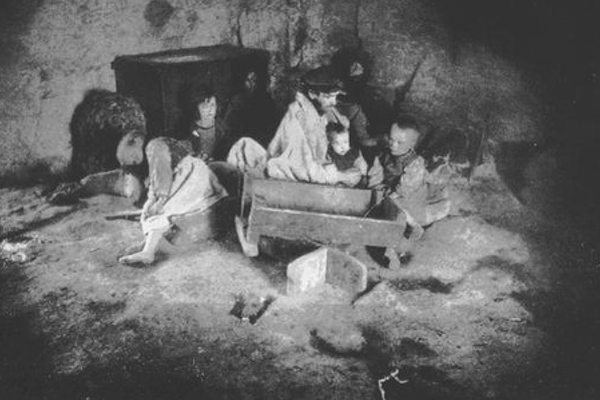Irish Legend Should Inspire the Fight Against Famine Today

An Irish family enduring starvation during the Great Famine in Carraroe, County Galway. National Library of Ireland.
The hit Irish show Riverdance includes a segment titled The Countess Cathleen, which was originally a verse drama by William Butler Yeats, published in 1893.
This legendary tale of Countess Cathleen (aka Kathleen) begins with Irish peasants starving to death during a famine. Demons have descended upon the desperate poor trying to get them to sell their souls to the Devil in exchange for gold to buy food. The wealthy Countess Cathleen tries to help the peasants by selling off her riches to buy food and end the starvation.
But the demons persist in stopping food from reaching the hungry, forcing the Countess Cathleen to offer her soul to them. The Countess Cathleen tells the demons, who are disguised as merchants, “These people starve, and therefore do they come Thronging to you. I hear a cry come from them, And it is in my ears by night and day."
Cathleen cannot ignore the suffering cries of the hungry. So she makes the deal with the Devil. Her soul is taken in exchange for food for the peasants and the return of any souls the demons had taken. The peasants are saved. The Countess Cathleen sadly dies.
But Cathleen’s story does not end. Her soul is later saved by angels because God realized she was trying to do good to save others. The evil demons are driven away.
While the story is fictitious, the idea of famine in Ireland was, of course, very real. Multiple famines struck Ireland during the 19th century and no doubt influenced the creation of the legend. The desperation in the story of those starving symbolizes the real life struggles people face during severe hunger emergencies.
When famine threatens a country, those starving are forced to sell precious assets, withdraw their children from school or send them into the streets to beg. Families will flee their homes in the search for food. When famine strikes, instability and chaos often follows.
And the evil of famine symbolized in The Countess Cathleen is very real to this day. In the story the demons interrupt Cathleen’s effort to feed the hungry, before taking her soul. In some conflicts food aid is blocked by armed forces from reaching those in need, a true act of evil.
For Ireland, preventing famine around the globe is an important mission as they know too well the horror of hunger. The Riverdance show, in keeping with this tradition, started fighting hunger at its creation. A video titled, Riverdance for Rwanda, was sold in 1994 to raise funds to feed the hungry in Rwanda.
That same spirit of the Irish in fighting hunger we need more than ever today. As the UN World Food Program warns “the number of acutely hungry people continues to increase at a pace that funding is unlikely to match, while the cost of delivering food assistance is at an all-time high because food and fuel prices have increased.”
There are many nations on the brink of famine including drought-ravaged Somalia where people are having to walk for days in the search of food and water. In war-torn Yemen, Burkina Faso, D.R. Congo, South Sudan, and the Sahel region of Africa hunger is at frightening levels. The UN World Food Program (WFP) and other relief agencies don’t have enough funding to keep up. WFP, UNICEF, CARE, Mary's Meals, Concern Worldwide, Save the Children, Mercy Corps and many other hunger fighting charities need our support.
The war in Ukraine has made the hunger crisis worse by causing havoc to one of the world’s breadbaskets. Food from Ukraine helps feed Somalia, Yemen and other countries in need during normal times. But this food is harder to reach since the war began and this precious supply is constantly in danger.
The evil of famine is hanging over many nations. We all can do more to feed the hungry especially the children who are most vulnerable to malnutrition. We can save lives and prevent famine in the true spirit of the Irish and Saint Patrick’s Day.